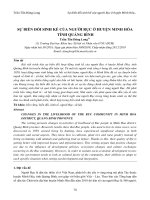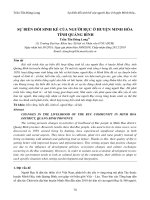41 quảng bình 2023
Bạn đang xem bản rút gọn của tài liệu. Xem và tải ngay bản đầy đủ của tài liệu tại đây (71.03 KB, 3 trang )
<span class="text_page_counter">Trang 1</span><div class="page_container" data-page="1">
<b>SỞ GIÁO DỤC VÀ ĐÀO TẠO I. Điền vào mỗi chỗ trống một từ thích hợp ở trong khung đề hoàn thành đoạn văn sau. (1,5 đ)</b>
If you live in a city, you will probably see many people, hear the noise of traffic, and smell
<b>the (1) _____________ from cars and factories. We are living in a new era in the history of theworld. Before this most people were fanners. They lived in small communities in the (2)</b>
_____________. Now many people are leaving the farms and moving into the cities. They are
<b>looking (3) _____________ better jobs. As a result, the cities arc growing very quickly. Most citiesare becoming more (4) _____________. People are driving more cars, burning more fuel, usingmore water, eating more food, making more garbage, and (5) _____________ more things infactories than ever before. Life in modem cities can (6) _____________ many opportunities, but</b>
also many difficulties.
<b>II. Đọc đoạn văn dưới đây và trả lời các câu hỏi. (1,0 đ)</b>
Every child in Great Britain between the age of five and fifteen must attend school. There are three main types of educational institutions: primary schools, secondary schools and universities.
State schools are free, and attendance is compulsory. Morning school begins at nine o'clock and lasts until half past four. School is open five days a week. On Saturdays and Sundays there are no lessons. There are holidays at Christmas. Easter and in summer. In London as in all cities there are two grades of state schools for those who will go to work at fifteen: primary schools for boys and girls between the ages of five and eleven, and secondary schools for children from eleven to fifteen years.
The lessons are reading, writing, the English language. English literature. English history, geography, science. Nature study, drawing, painting, singing, woodwork and drill.
<b>7. What are three main types of educational institutions?</b>
</div><span class="text_page_counter">Trang 2</span><div class="page_container" data-page="2"><b>10. When do pupils have holidays?</b>
______________________________________________________________________________
<b>III. Chọn đáp án đúng trong số A, B, C hoặc D để hoàn thành các câu sau. (2,0 đ)11. Mary often watches television after dinner, _____________?</b>
A. doesn’t she B. did she C. does she D. didn't she
<b>12. Mary speaks English _____________ than her brother.</b>
A. more fluent B. fluent C. more fluently D. fluently
<b>13. The material and design of clothes for men are different _____________ those for women.</b>
<b>14. The hat _____________ my mother gave me on my birthday is very beautiful.</b>
<b>15. Due to the bad weather, the flight to Ha Noi was _____________.</b>
<b>16. Peter and David are talking about the way to save electricity.</b>
<i><b>- Peter: think we should use energy-saving bulbs to save electricity.” – David: “_____________”</b></i>
C. Good but I don’t want to. D. That’s a good idea.
<b>17. My father works in a big company with high salary and he is the _____________ of my family.</b>
Mother stays at home and does the housework.
A. tutor B. breadwinner C. facilitator D. adviser
<b>18. I am _____________ that people have spoiled this area.</b>
A. disappointing B. disappointment C. disappointed D. disappoint
<b>IV. Chọn từ trong số A, B, C hoặc D có phần gạch chân được phát âm khác với phần gạch châncủa những từ còn lại. (0,5 đ)</b>
<b>V. Chọn từ trong số A, B, C hoặc D có trọng âm chính rơi vào vị trí khác so với các từ còn lại. (0,5đ).</b>
<b>21. A. consider </b> B. develop C. embroider D. understand
<b>VI. Biến đổi từ trong ngoặc ở dạng đúng để hoàn thành các câu sau. (0,5 đ)23. This coat is nice and ___________ so I really like wearing it. (COMFORT)24. They had a happy ___________ together when they were little kids. (CHILD)</b>
<b>VII. Viết lại các câu sau bắt đầu bằng từ hoặc cụm từ cho sẵn sao cho nghĩa của câu không thay</b>
</div><span class="text_page_counter">Trang 3</span><div class="page_container" data-page="3"><b>đổi (1,5 đ)</b>
<b>25. Despite the difficult question, Linda solved it in two minutes.</b>
Although the
<b>26. “I want to send my daughter to a university in Australia,” she said.</b>
She said that
<b>27. I haven’t met my old teacher for 5 months.</b>
The last time I
<b>VIII. Sử dụng các từ và cụm từ gợi ý để viết thành câu hoàn chỉnh. (1,0 đ) 28. Last week, he/ suggest/ go/ Phong Nha cave / but/I/ be/ busy.</b>
______________________________________________________________________________
<b>29. My mother/ be/ the person/ teach/ me/ first lesson on kindness.</b>
______________________________________________________________________________
<b>IX. Sử dụng động từ trong ngoặc ở dạng hoặc thì đúng để hồn thành cúc câu sau. (1,5 d)30. When the phone rang last night, I (listen) ____________ to music.</b>
<b>31. I can’t buy that smartphone. I wish I (have) ____________ enough money to buy it.32. It’s not easy (operate) ____________ this machine without the instructions.</b>
<b>33. If you (give) ____________ her this gift, she would be happy.34. Tim enjoys (play) ____________ volleyball in his free time.35. Many trees (plant) ____________ in my school every year.</b>
<i>Thí sinh khơng được sử dụng tàỉ liệu. Cán bộ coi thi khơng giải thích gì thêm.</i>
</div>








